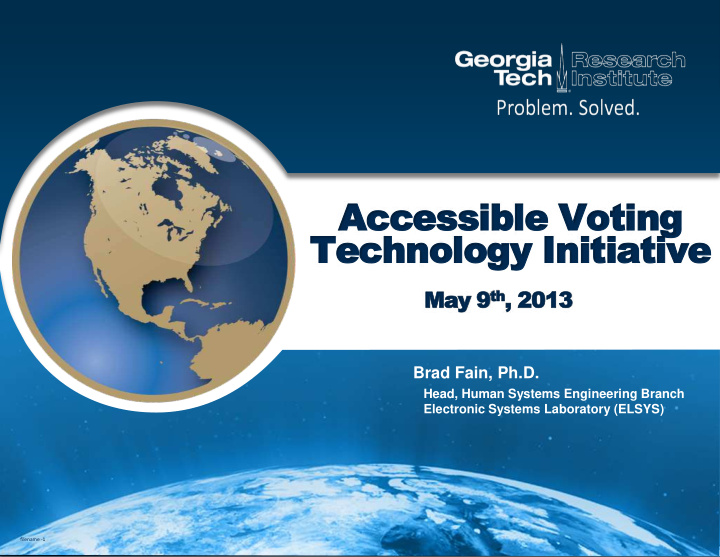



Accessible Voting Technology Initiative May 9 th th , 2013 Brad Fain, Ph.D. Head, Human Systems Engineering Branch Electronic Systems Laboratory (ELSYS) filename -1
Military Heroes Summary of Results • The needs of recently wounded service members and veterans are similar • Technology solutions will be ineffective without corresponding policy solutions • Newly injured service members have little to no experience with assistive technologies • Current accessibility solutions might not be optimal • Ballot design issues are at least as important as ballot delivery and marking issues • Characteristic injuries impact memory and attention • Complexity is a barrier for many • Need for further research to address needs of those with cumulative mTBI / TBI / PTSD injuries 2
AVTI Challenge Collected data from users with disabilities, voting system testing vendors, voting system designers, voting data exchange experts (P1622), and election officials People with disabilities may not be able to participate independently in the electoral process due to: • Difficulty using existing voting systems • Lack of accommodation of ‘hidden disabilities’ • Usability issues with paper ballots and DREs • Lack of scientific data to support selection of design features • Complexity and expense of setting up and configuring accessible technologies Can a low cost tablet be adapted to interface with the Military Heroes Voting Test Bed to research voting accessibility and usability? EAC Voting Mtg May 9
Tablet Test Bed Interface Tablet Layout filename -4
Tablet Test Bed Interface Rendering filename -5
Tablet Test Bed Interface Rendering filename -6
Research Ballot Design and Interface Research • Previously tested a young adult population • Currently evaluating older adults, adults with arthritis, and adults with other disabilities Collected eye-tracking, timing, and selection data, as well as system usability survey filename -7
Research • Dyslexia Font Usability Study • To evaluate different dyslexia fonts that have been developed for the web: OpenDyslexia and Lexicon • Determine whether these dyslexia fonts assist people with dyslexia in the voting process. • Recruit 16 participants with dyslexia, and 16 age and gender matched control group. • Currently being executed. Anticipated completion June 30, 2013. filename -8
Research • Use of Plain Language (PL) in Spanish and Chinese • Replication of NIST PL study (NISTIR 7556) in both Spanish and Chinese languages • Investigate the following: • Do participants vote more accurately on PL or traditional ballot? • Do they perform better on traditional ballot if they voted the PL ballot first? • Is education a factor in performance on either ballots? filename -9
Thank You! Brad Fain Carrie Bell Andrew Baranak Linda Harley Principal Investigator Research Scientist II Research Scientist I Research Scientist II Matt Hung Sarah Farmer Chandler Price GRA - Programmer GRA - Statistics SA - EyeTracker filename -10
Recommend
More recommend